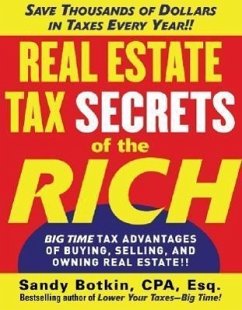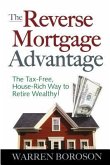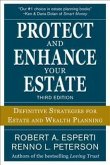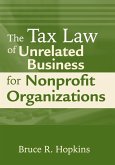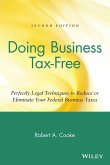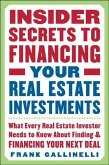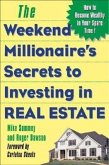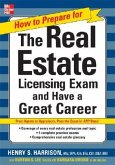Sandy Botkin
Real Estate Tax Secrets of the Rich
Big-Time Tax Advantages of Buying, Selling, and Owning Real Estate
Sandy Botkin
Real Estate Tax Secrets of the Rich
Big-Time Tax Advantages of Buying, Selling, and Owning Real Estate
- Broschiertes Buch
- Merkliste
- Auf die Merkliste
- Bewerten Bewerten
- Teilen
- Produkt teilen
- Produkterinnerung
- Produkterinnerung
IRS insider Sandy Botkin reveals the tax strategies you can use to increase your ROIs by as much as 20 percent-whether you're a home owner or a real estate investor. This accessible guide demystifies real estate taxes and shows how to achieve maximum benefit when buying, owning, selling, managing, repairing, and investing in properties. * Features numerous forms, charts, sample documents, and other valuable tax-saving tools * Gives you the basics on real estate taxes and shows how to take full advantage of tax loopholes
Andere Kunden interessierten sich auch für
![The Reverse Mortgage Advantage: The Tax-Free, House Rich Way to Retire Wealthy! The Reverse Mortgage Advantage: The Tax-Free, House Rich Way to Retire Wealthy!]() Warren BorosonThe Reverse Mortgage Advantage: The Tax-Free, House Rich Way to Retire Wealthy!29,99 €
Warren BorosonThe Reverse Mortgage Advantage: The Tax-Free, House Rich Way to Retire Wealthy!29,99 €![Protect and Enhance Your Estate: Definitive Strategies for Estate and Wealth Planning 3/E Protect and Enhance Your Estate: Definitive Strategies for Estate and Wealth Planning 3/E]() Robert a EspertiProtect and Enhance Your Estate: Definitive Strategies for Estate and Wealth Planning 3/E37,99 €
Robert a EspertiProtect and Enhance Your Estate: Definitive Strategies for Estate and Wealth Planning 3/E37,99 €![The Tax Law of Unrelated Business for Nonprofit Organizations The Tax Law of Unrelated Business for Nonprofit Organizations]() Bruce R HopkinsThe Tax Law of Unrelated Business for Nonprofit Organizations93,99 €
Bruce R HopkinsThe Tax Law of Unrelated Business for Nonprofit Organizations93,99 €![Doing Business Tax-Free Doing Business Tax-Free]() Robert A CookeDoing Business Tax-Free22,99 €
Robert A CookeDoing Business Tax-Free22,99 €![Insider Secrets to Financing Your Real Estate Investments Insider Secrets to Financing Your Real Estate Investments]() Frank GallinelliInsider Secrets to Financing Your Real Estate Investments29,99 €
Frank GallinelliInsider Secrets to Financing Your Real Estate Investments29,99 €![The Weekend Millionaire's Secrets to Investing in Real Estate: How to Become Wealthy in Your Spare Time The Weekend Millionaire's Secrets to Investing in Real Estate: How to Become Wealthy in Your Spare Time]() Mike SummeyThe Weekend Millionaire's Secrets to Investing in Real Estate: How to Become Wealthy in Your Spare Time28,99 €
Mike SummeyThe Weekend Millionaire's Secrets to Investing in Real Estate: How to Become Wealthy in Your Spare Time28,99 €![How to Prepare for and Pass the Real Estate Licensing Exam: Ace the Exam in Any State the First Time! How to Prepare for and Pass the Real Estate Licensing Exam: Ace the Exam in Any State the First Time!]() Henry HarrisonHow to Prepare for and Pass the Real Estate Licensing Exam: Ace the Exam in Any State the First Time!27,99 €
Henry HarrisonHow to Prepare for and Pass the Real Estate Licensing Exam: Ace the Exam in Any State the First Time!27,99 €-
-
-
IRS insider Sandy Botkin reveals the tax strategies you can use to increase your ROIs by as much as 20 percent-whether you're a home owner or a real estate investor. This accessible guide demystifies real estate taxes and shows how to achieve maximum benefit when buying, owning, selling, managing, repairing, and investing in properties. * Features numerous forms, charts, sample documents, and other valuable tax-saving tools * Gives you the basics on real estate taxes and shows how to take full advantage of tax loopholes
Hinweis: Dieser Artikel kann nur an eine deutsche Lieferadresse ausgeliefert werden.
Hinweis: Dieser Artikel kann nur an eine deutsche Lieferadresse ausgeliefert werden.
Produktdetails
- Produktdetails
- Verlag: McGraw Hill LLC
- Seitenzahl: 240
- Erscheinungstermin: 3. November 2006
- Englisch
- Abmessung: 234mm x 188mm x 17mm
- Gewicht: 426g
- ISBN-13: 9780071472357
- ISBN-10: 0071472355
- Artikelnr.: 21087043
- Herstellerkennzeichnung
- Libri GmbH
- Europaallee 1
- 36244 Bad Hersfeld
- gpsr@libri.de
- Verlag: McGraw Hill LLC
- Seitenzahl: 240
- Erscheinungstermin: 3. November 2006
- Englisch
- Abmessung: 234mm x 188mm x 17mm
- Gewicht: 426g
- ISBN-13: 9780071472357
- ISBN-10: 0071472355
- Artikelnr.: 21087043
- Herstellerkennzeichnung
- Libri GmbH
- Europaallee 1
- 36244 Bad Hersfeld
- gpsr@libri.de
McGraw-Hill authors represent the leading experts in their fields and are dedicated to improving the lives, careers, and interests of readers worldwide
Part I - Overview of Real Estate
Chapter I: Why Everyone in America Should Own Their Home
Chapter II:
Buy a Home or Die in Poverty
Part II - Tax Goodies from Owning a Home
Chapter III:
Tax Basis - the Starting Place for All Deductions
Chapter IV:
IRS Record-Keeping Requirements to Bullet-Proof Your Basis
Chapter V:
Why Making Improvements to Your Home is Much More Valuable than Making
Repairs
Chapter VI:
Maximizing the New Mortgage Interest Rules
Chapter VII:
The Point of Points
Chapter VIII:
Maximizing Your Deductions when Building a Home
Chapter IX:
Maximizing the Effect of Real Estate Taxes
Part III - Maximizing Tax Benefits when You Dispose of Your Home
Chapter X:
Excluding Gain when You Sell Your Home - an Overview to the New Universal
Exclusion
Chapter XI:
Exceptions to the Two-Year Rule
Chapter XII:
Divorce and Death Implications
Chapter XIII:
Using an S Corporation to Avoid the Two-Year Rule
Part IV - Introduction to Tax Planning for Buying andLooking for Rental
Property
Chapter XIV:
Introduction to Investment Property
Chapter XV:
Understanding Depreciation
Chapter XVI:
How to Evaluate Rates of Return for Residential Investment Property
Chapter XVII:
How to Deduct the Cost of Looking for Property
Part V - Tax Goodies Incurred while Owning Rental Property
Chapter XVIII:
Minimizing Passive Loss Problems
Chapter XIX:
Maximizing Your Depreciation Deductions
Chapter XX:
Making Land Deductible
Chapter XXI:
Income Splitting by Hiring Family Members
Chapter XXII:
Why Repairs on Investment Property are Important
Part VI - Minimizing Taxes when Disposing of Real Estate
Chapter XXIII:
How to Calculate Gain or Loss
Chapter XXIV:
When to Use Seller Financing
Chapter XXV:
How to Avoid All Gain on the Sale of Investment Property Using Like-Kind
Exchanges
Chapter XXVI:
Sales to Relatives
Part VII - Miscellaneous Real Estate Tax Considerations
Chapter XXVII:
Understanding Vacation Home and Second Home Rules
Chapter XXVIII:
Understanding the Benefits of "Mom and Dad" Motels, Owning Bed and
Breakfasts, and Converting Rental Property to a Hotel Classification
Chapter XXIX:
Frequently Asked Questions
Appendix
Chapter I: Why Everyone in America Should Own Their Home
Chapter II:
Buy a Home or Die in Poverty
Part II - Tax Goodies from Owning a Home
Chapter III:
Tax Basis - the Starting Place for All Deductions
Chapter IV:
IRS Record-Keeping Requirements to Bullet-Proof Your Basis
Chapter V:
Why Making Improvements to Your Home is Much More Valuable than Making
Repairs
Chapter VI:
Maximizing the New Mortgage Interest Rules
Chapter VII:
The Point of Points
Chapter VIII:
Maximizing Your Deductions when Building a Home
Chapter IX:
Maximizing the Effect of Real Estate Taxes
Part III - Maximizing Tax Benefits when You Dispose of Your Home
Chapter X:
Excluding Gain when You Sell Your Home - an Overview to the New Universal
Exclusion
Chapter XI:
Exceptions to the Two-Year Rule
Chapter XII:
Divorce and Death Implications
Chapter XIII:
Using an S Corporation to Avoid the Two-Year Rule
Part IV - Introduction to Tax Planning for Buying andLooking for Rental
Property
Chapter XIV:
Introduction to Investment Property
Chapter XV:
Understanding Depreciation
Chapter XVI:
How to Evaluate Rates of Return for Residential Investment Property
Chapter XVII:
How to Deduct the Cost of Looking for Property
Part V - Tax Goodies Incurred while Owning Rental Property
Chapter XVIII:
Minimizing Passive Loss Problems
Chapter XIX:
Maximizing Your Depreciation Deductions
Chapter XX:
Making Land Deductible
Chapter XXI:
Income Splitting by Hiring Family Members
Chapter XXII:
Why Repairs on Investment Property are Important
Part VI - Minimizing Taxes when Disposing of Real Estate
Chapter XXIII:
How to Calculate Gain or Loss
Chapter XXIV:
When to Use Seller Financing
Chapter XXV:
How to Avoid All Gain on the Sale of Investment Property Using Like-Kind
Exchanges
Chapter XXVI:
Sales to Relatives
Part VII - Miscellaneous Real Estate Tax Considerations
Chapter XXVII:
Understanding Vacation Home and Second Home Rules
Chapter XXVIII:
Understanding the Benefits of "Mom and Dad" Motels, Owning Bed and
Breakfasts, and Converting Rental Property to a Hotel Classification
Chapter XXIX:
Frequently Asked Questions
Appendix
Part I - Overview of Real Estate
Chapter I: Why Everyone in America Should Own Their Home
Chapter II:
Buy a Home or Die in Poverty
Part II - Tax Goodies from Owning a Home
Chapter III:
Tax Basis - the Starting Place for All Deductions
Chapter IV:
IRS Record-Keeping Requirements to Bullet-Proof Your Basis
Chapter V:
Why Making Improvements to Your Home is Much More Valuable than Making
Repairs
Chapter VI:
Maximizing the New Mortgage Interest Rules
Chapter VII:
The Point of Points
Chapter VIII:
Maximizing Your Deductions when Building a Home
Chapter IX:
Maximizing the Effect of Real Estate Taxes
Part III - Maximizing Tax Benefits when You Dispose of Your Home
Chapter X:
Excluding Gain when You Sell Your Home - an Overview to the New Universal
Exclusion
Chapter XI:
Exceptions to the Two-Year Rule
Chapter XII:
Divorce and Death Implications
Chapter XIII:
Using an S Corporation to Avoid the Two-Year Rule
Part IV - Introduction to Tax Planning for Buying andLooking for Rental
Property
Chapter XIV:
Introduction to Investment Property
Chapter XV:
Understanding Depreciation
Chapter XVI:
How to Evaluate Rates of Return for Residential Investment Property
Chapter XVII:
How to Deduct the Cost of Looking for Property
Part V - Tax Goodies Incurred while Owning Rental Property
Chapter XVIII:
Minimizing Passive Loss Problems
Chapter XIX:
Maximizing Your Depreciation Deductions
Chapter XX:
Making Land Deductible
Chapter XXI:
Income Splitting by Hiring Family Members
Chapter XXII:
Why Repairs on Investment Property are Important
Part VI - Minimizing Taxes when Disposing of Real Estate
Chapter XXIII:
How to Calculate Gain or Loss
Chapter XXIV:
When to Use Seller Financing
Chapter XXV:
How to Avoid All Gain on the Sale of Investment Property Using Like-Kind
Exchanges
Chapter XXVI:
Sales to Relatives
Part VII - Miscellaneous Real Estate Tax Considerations
Chapter XXVII:
Understanding Vacation Home and Second Home Rules
Chapter XXVIII:
Understanding the Benefits of "Mom and Dad" Motels, Owning Bed and
Breakfasts, and Converting Rental Property to a Hotel Classification
Chapter XXIX:
Frequently Asked Questions
Appendix
Chapter I: Why Everyone in America Should Own Their Home
Chapter II:
Buy a Home or Die in Poverty
Part II - Tax Goodies from Owning a Home
Chapter III:
Tax Basis - the Starting Place for All Deductions
Chapter IV:
IRS Record-Keeping Requirements to Bullet-Proof Your Basis
Chapter V:
Why Making Improvements to Your Home is Much More Valuable than Making
Repairs
Chapter VI:
Maximizing the New Mortgage Interest Rules
Chapter VII:
The Point of Points
Chapter VIII:
Maximizing Your Deductions when Building a Home
Chapter IX:
Maximizing the Effect of Real Estate Taxes
Part III - Maximizing Tax Benefits when You Dispose of Your Home
Chapter X:
Excluding Gain when You Sell Your Home - an Overview to the New Universal
Exclusion
Chapter XI:
Exceptions to the Two-Year Rule
Chapter XII:
Divorce and Death Implications
Chapter XIII:
Using an S Corporation to Avoid the Two-Year Rule
Part IV - Introduction to Tax Planning for Buying andLooking for Rental
Property
Chapter XIV:
Introduction to Investment Property
Chapter XV:
Understanding Depreciation
Chapter XVI:
How to Evaluate Rates of Return for Residential Investment Property
Chapter XVII:
How to Deduct the Cost of Looking for Property
Part V - Tax Goodies Incurred while Owning Rental Property
Chapter XVIII:
Minimizing Passive Loss Problems
Chapter XIX:
Maximizing Your Depreciation Deductions
Chapter XX:
Making Land Deductible
Chapter XXI:
Income Splitting by Hiring Family Members
Chapter XXII:
Why Repairs on Investment Property are Important
Part VI - Minimizing Taxes when Disposing of Real Estate
Chapter XXIII:
How to Calculate Gain or Loss
Chapter XXIV:
When to Use Seller Financing
Chapter XXV:
How to Avoid All Gain on the Sale of Investment Property Using Like-Kind
Exchanges
Chapter XXVI:
Sales to Relatives
Part VII - Miscellaneous Real Estate Tax Considerations
Chapter XXVII:
Understanding Vacation Home and Second Home Rules
Chapter XXVIII:
Understanding the Benefits of "Mom and Dad" Motels, Owning Bed and
Breakfasts, and Converting Rental Property to a Hotel Classification
Chapter XXIX:
Frequently Asked Questions
Appendix

